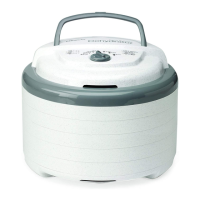
Do you have a question about the Nesco FD-75A and is the answer not in the manual?
| Type | Food Dehydrator |
|---|---|
| Manufacturer | Nesco |
| Model Number | FD-75A |
| Wattage | 600 watts |
| Temperature Range | 95°F to 160°F |
| Number of Trays | 5 |
| Material | Plastic |
| Color | White |
| Fan Location | Top |
| Expandable Trays | Yes |
Instructions for cleaning dehydrator trays and base, including dishwasher safety.
Guidelines for cleaning the power head unit, emphasizing avoiding water contact.
Advice on choosing the best quality, ripe produce for dehydration to ensure optimal results.
Instructions on how to evenly arrange food pieces on trays to ensure efficient and uniform drying.
Information on factors influencing drying duration and how the dehydrator's design affects speed.
Guidelines for selecting the best quality, ripe, and unblemished fruits for dehydration.
Steps for washing, peeling, slicing, and 'checking' fruits to prepare them for the dehydration process.
Advice on choosing fruits for fruit rolls, including combinations and using slightly overripe fruits.
Steps for puréeing fruit for fruit rolls, including adding sweeteners if needed for tartness.
Guidance on selecting fresh, crisp vegetables for the best quality dehydrated product.
Steps for washing, peeling, trimming, coring, and slicing vegetables prior to dehydration.
Explains the necessity of blanching most vegetables to slow enzyme action and improve dehydration.
Detailed instructions on performing steam blanching for vegetables using a steamer or pan.
Information on making homemade jerky from various meats, emphasizing lean cuts and cost savings.
Guidance on selecting meats, using ground meat kits, and general drying procedures for jerky.
Steps for removing fat, cutting meat into uniform strips for optimal drying and tenderness.
Guidance on choosing fresh fish for jerky, and considerations for frozen fish quality.
Steps for cutting fish into strips and marinating with salt for jerky preparation.
Recommended drying temperatures and texture for fish jerky.
Guidelines for packaging and storing dried fish jerky to prevent spoilage.
Advice on when and how to gather herbs for drying to maximize flavor and aroma.
Steps for washing, cleaning, and preparing herbs, especially large-leafed ones, for drying.
A recipe for making banana bread using dried bananas, nuts, and dates for a breakfast bread.
A recipe for bran muffins that can be enjoyed for breakfast or packed for lunch.
A recipe for making homemade turkey and sweet potato treats for dogs.
Instructions for preserving flowers by drying them on trays for arrangements and decorations.
Method for using desiccant powder to speed up flower drying and preserve vibrant colors.
Techniques for shaping, joining, and adding impressions to dough for ornaments.
Flexible screens that make drying sticky foods and small items easier.
Sheets designed for making fruit rolls and drying liquids like soups and sauces.
Kits for making jerky at home, available in various flavors.
Trays designed to expand the drying capacity of the dehydrator.